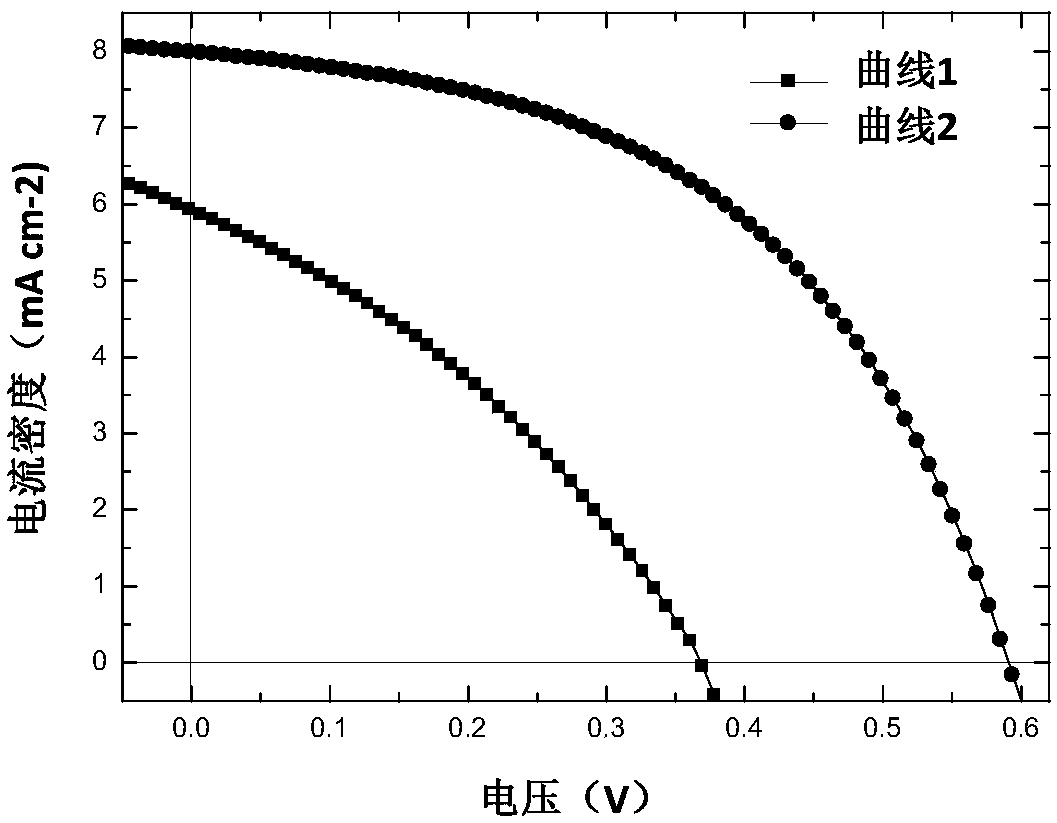A preparation method of Bi2O2S coated nanorod array and its application in solar cell
A nanorod array and nanorod technology, applied in the field of solar cells, can solve problems such as easy generation of surface defects, and achieve the effects of improving charge transfer efficiency, strong visible light absorption range, and improving defects
- Summary
- Abstract
- Description
- Claims
- Application Information
AI Technical Summary
Problems solved by technology
Method used
Image
Examples
Embodiment 1
[0038] The structure of the organic solar cell device in which the electron transport layer is coated zinc oxide nanorods in this example is: ITO / ZnO:Bi 2 o 2 S / P3HT:PCBM / MoO 3 / Ag.
[0039] The preparation process of the appeal doped organic solar cell is as follows:
[0040] Step 1. Use detergent, deionized water, titanium tetrachloride aqueous solution, acetone, absolute ethanol, and isopropanol to ultrasonically clean for 10 minutes in sequence; this time, dry in a vacuum oven at 80°C. Perform plasma surface treatment on the surface of the cleaned and dried cathode substrate (ITO) for 10 minutes to clean the residual organic matter on the ITO surface and improve its work function.
[0041] Step 2. Spin-coat ZnO solution on the surface of ITO treated in step 1, the rotation speed is 3500rpm, and the time is 40s; anneal the cathode substrate that has been spin-coated with zinc oxide, the temperature is 200°C, the time is 30 minutes, ZnO The thickness of the seed layer is...
Embodiment 2
[0052] The organic solar cell device structure in the present embodiment 2 is: ITO / ZnO:Bi 2 o 2 S / P3HT:PCBM / MoO 3 / Ag.
[0053] The preparation process of the appeal organic solar cell is as follows:
[0054] Step 1. Use detergent, deionized water, titanium tetrachloride aqueous solution, acetone, absolute ethanol, and isopropanol to ultrasonically clean for 10 minutes in sequence; this time, dry in a vacuum oven at 80°C. Perform plasma surface treatment on the surface of the cleaned and dried cathode substrate (ITO) for 10 minutes to clean the residual organic matter on the ITO surface and improve its work function.
[0055] Step 2. Spin-coat ZnO solution on the surface of ITO treated in step 1, the rotation speed is 3500rpm, and the time is 40s; anneal the cathode substrate that has been spin-coated with zinc oxide, the temperature is 200°C, the time is 30 minutes, ZnO The thickness of the seed layer is 5 nm.
[0056] Step 3, growing ZnO nanorods on the ZnO seed layer t...
Embodiment 3
[0062] The doped organic solar cell device structure in the present embodiment 3 is: ITO / ZnO:Bi 2 o 2 S / P3HT:PCBM / MoO 3 / Ag.
[0063] The preparation process of the appeal organic solar cell is as follows:
[0064] Step 1. Ultrasonic cleaning with detergent, deionized water, titanium tetrachloride aqueous solution, acetone, absolute ethanol, and isopropanol for 10 minutes in sequence; this time, dry in a vacuum oven at 80°C. Perform plasma surface treatment on the surface of the cleaned and dried cathode substrate (ITO) for 10 minutes to clean the residual organic matter on the ITO surface and improve its work function.
[0065] Step 2, carry out 10 minutes of plasma surface treatment on the surface of the cathode substrate (ITO) that has been cleaned and dried. This treatment method utilizes the strong oxidizing properties of ozone generated under microwaves to clean the residual organic matter on the ITO surface, etc., and simultaneously can make the ITO surface oxygen T...
PUM
| Property | Measurement | Unit |
|---|---|---|
| Thickness | aaaaa | aaaaa |
| Concentration | aaaaa | aaaaa |
| Length | aaaaa | aaaaa |
Abstract
Description
Claims
Application Information
 Login to View More
Login to View More - R&D
- Intellectual Property
- Life Sciences
- Materials
- Tech Scout
- Unparalleled Data Quality
- Higher Quality Content
- 60% Fewer Hallucinations
Browse by: Latest US Patents, China's latest patents, Technical Efficacy Thesaurus, Application Domain, Technology Topic, Popular Technical Reports.
© 2025 PatSnap. All rights reserved.Legal|Privacy policy|Modern Slavery Act Transparency Statement|Sitemap|About US| Contact US: help@patsnap.com



